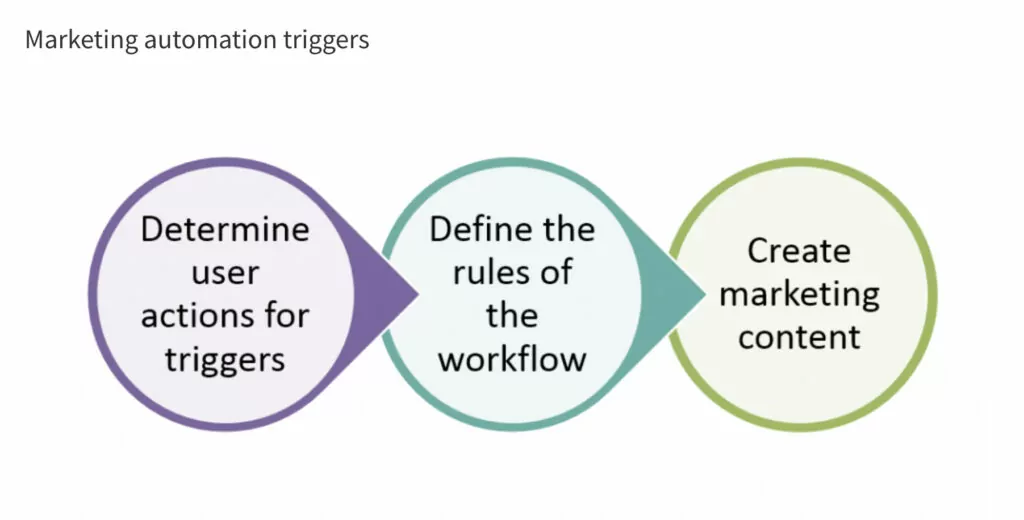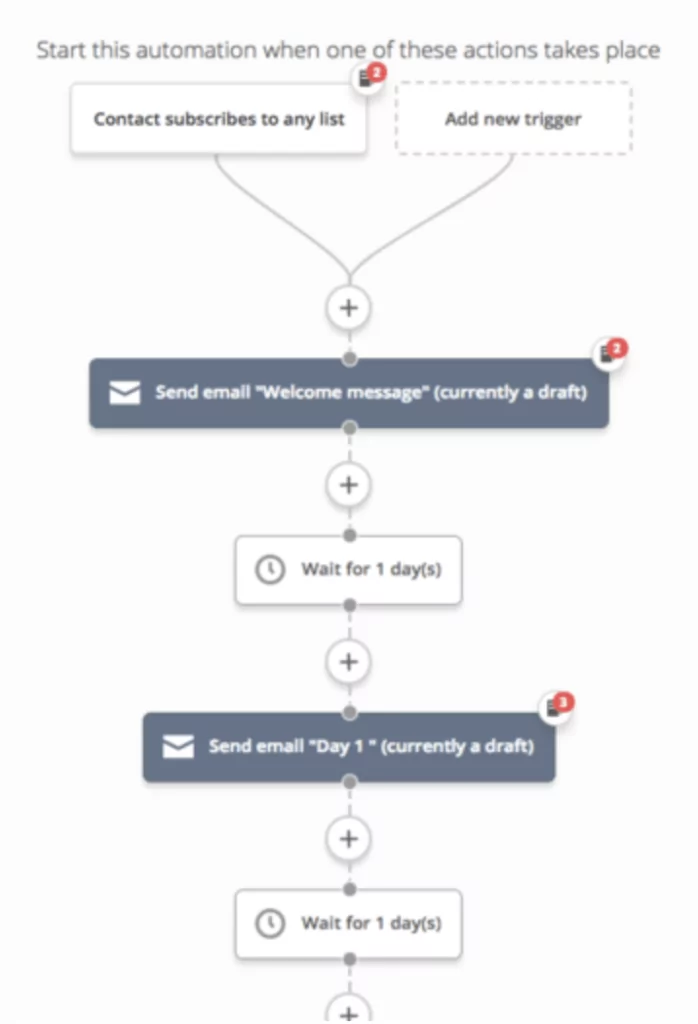Using automation in marketing helps you respond faster to potential leads and increase conversions. Instead of manually setting off a series of events, you can establish triggers and responses that ensure your marketing processes perform seamlessly. A marketing automation workflow is also scalable, allowing you to reach more leads in less time.
Explore 10 marketing automation ideas that are most effective in 2022, along with marketing workflow examples.
Key Takeaways:
- Marketing automation workflows are a series of tasks that automatically occur in response to customer action.
- Many marketing automation workflows are emails that go out in response to how customers engage with your website.
- Through marketing automation workflows, you can respond faster with more relevant information.
How Marketing Automation Works
Marketing automation workflows are a string of reactions that automatically occur after a trigger action. One example of workflow automation is when someone fills in a form on your website. Your workflow then sends five marketing emails that greet the new lead, educate them on your brand, introduce your products, and convert them into customers.
Each marketing workflow requires trigger and response actions. Triggers are the original actions that customers perform that start a workflow process. Response actions are automated marketing tasks that your platform completes without human intervention.
Some examples of triggers include:
- Adding new leads to one of your lead lists
- A lead’s profile information changed
- A lead interacted with an email
- A lead unsubscribed from your lists
- Someone submitted a website form
- New traffic visited a website page
These triggers can change how leads are processed, set off a series of emails, or affect how your website responds to the lead’s action.
Source: Freshsales Blog
10 Workflows Every Marketer Needs to Use
Here are ten automated workflows every marketer should include in their strategies.
1. Welcome New Leads
One of the most basic forms of workflow automation is welcome emails. You send these emails to first-time visitors, buyers, or new leads. For example, a welcome email is often sent when someone signs up for a newsletter, creates an account, or purchases their first product.
The average email open rate is 21%. However, welcome emails have an open rate of 82%. Automating your welcome email workflow ensures you don’t miss out on a potential new customer and allows you to respond to more first-time visitors.
Source: trueNorth
2. Nurture Current Leads
Using automated lead nurturing increases your qualified leads by 451%. Lead nurturing is the process of walking your customers through their journey so that you can address any questions and remove roadblocks along the way.
You can perform lead nurturing through a series of automated marketing emails.
3. Perform Lead Qualification Processes
Lead qualification is necessary to avoid wasting time on weak leads, distributing your qualified leads to the right representatives, and speeding up your response time.
Setting up an automated workflow for lead qualification allows you to analyze more leads in a shorter time. Your lead qualification workflow can pull all that contact’s data and use it to map their interactions with your brand and their demographics. These insights help you score the leads depending on how likely they are to buy. This saves you time and helps you focus on the highest value leads.
4. Remind Consumers of Abandoned Tasks
Customers often begin a process on your website but become distracted halfway through. Instead of losing those leads, you can automate an abandoned task email. For instance, the cart abandonment rate is 88.1%, but abandoned cart emails can earn back 3%-14% of your lost sales.
5. Reengage an Inactive Lead
Salesforce defines an inactive lead as someone who hasn’t purchased or accessed your product in 30 days. About 82% of companies say that retaining loyal customers is more cost-efficient than attracting new customers. Therefore, if you have an inactive lead, don’t discard them.
Instead, use an automated workflow to reengage the leads by sending a series of nurturing emails to remind the lead about your fantastic company and some new products that might interest them.
6. Stop Traffic from Exiting a Website Page
You can embed some workflows into your website to guide your traffic toward specific pages. For example, you might set up an automatic chat message that your traffic receives when they click on your product page.
Another popular website workflow is the re-engagement pop-up. These pop-up windows appear after your visitors are on your page for a designated amount of time or if they reach a specific point on the page. The pop-up might read something like, “Going so soon? Check out XYZ.” These messages reengage visitors and encourage them to stay on your site longer by showing them related content.
7. Fill Out Online Forms
Whenever a visitor fills out a form on your website, you can use that as a trigger event for a series of follow-up emails. For example, they might fill in a contact form, an interest form, or enter their information for a download.
Since you want to respond quickly after someone expresses interest, you can set up a workflow of emails that they receive related to the trigger event. If you can respond to a lead within 30 minutes, you are 21 times more likely to qualify that lead.
8. Generate Feedback
About 93% of customers use online reviews when making a purchasing decision. Feedback isn’t just for generating trust with future customers but also for growing as a company.
You can increase the amount of feedback you receive by establishing a workflow where customers receive a feedback request after interacting with your business. For example, they might receive an email after purchasing or interacting with customer support.
9. Reminder Emails
Customers will often forget important information like subscription renewal deadlines or upcoming events.
Reminder emails are a helpful way to keep your loyal customers engaged and make sure they don’t miss payments or renewals. Email workflows are also ways to encourage them to attend webinars or other events they signed up for.
10. Special Occasion Emails
Celebrating your customers is one way to encourage customer loyalty. Setting up a workflow that sends celebratory emails with special offers is one small way to show your customers you care. Some trigger events you might use for your email marketing automation strategy include:
- Customer birthdays
- Customer anniversaries
- Loyalty anniversaries
- Holidays
- Company sales or special promotions
Automate More of Your Marketing Workflows
You will lose fewer leads and convert more prospects into customers by automating your workflows through MXTR’s platform.
Schedule a demo and learn more about our automated workflow process.
Featured Image: istockphoto









